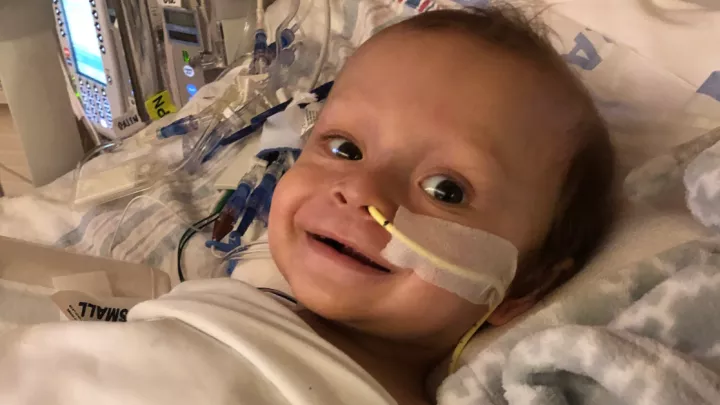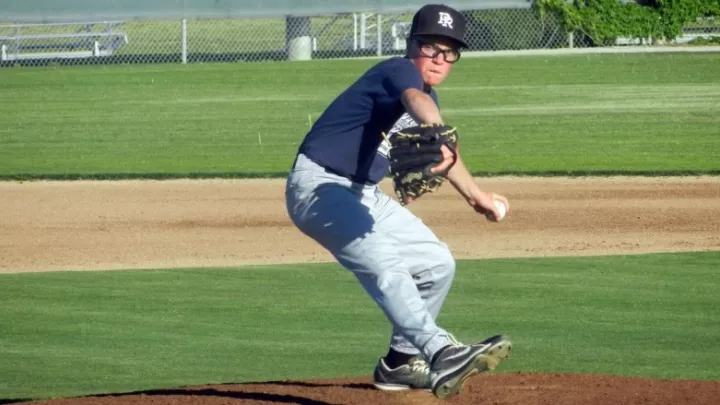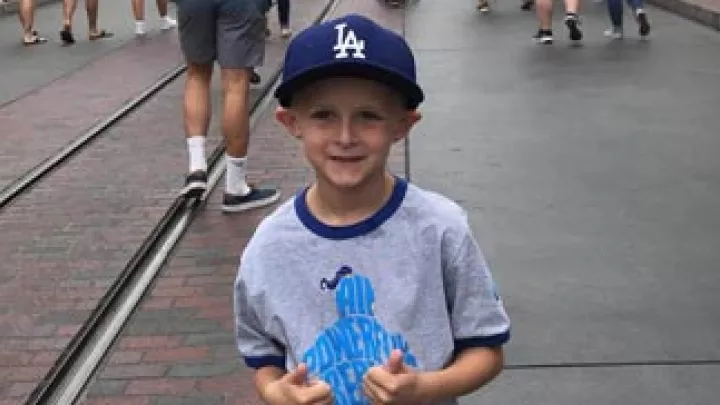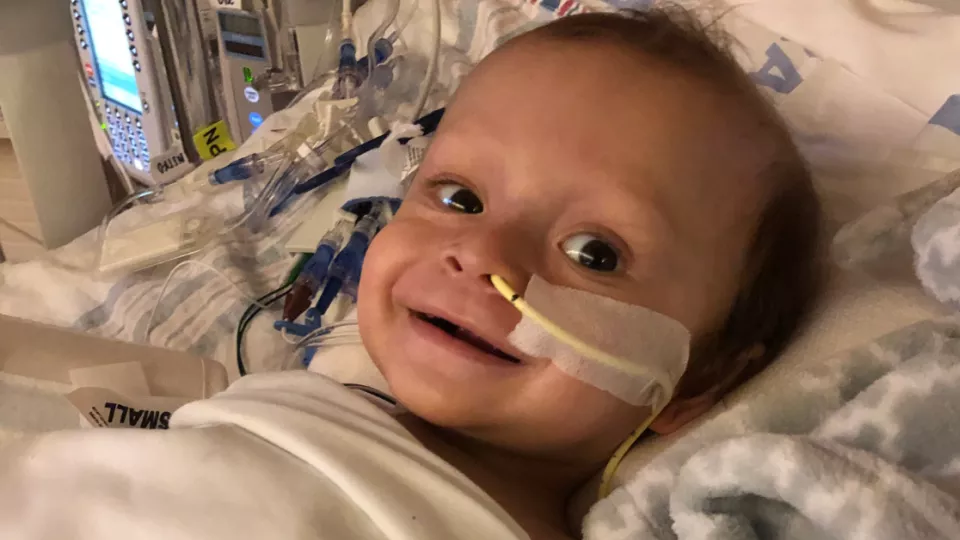
A Stranger’s Gift Leads to Milestone Liver Transplant
You could begin the story of the 400th pediatric liver transplant at Children’s Hospital Los Angeles in a lot of different places.
You could start, of course, on Sept. 30, 1998, when the Liver and Intestinal Transplant Program performed its first living donor liver transplant—led by Yuri Genyk, MD, the same surgeon who has since led 400 transplants.
Or, you could start on Dec. 15, 2019, when parents Aileen and Chad noticed that the eyes of their 2-day-old baby, Jacob, had turned yellow.
But really, this extraordinary story begins much, much earlier. It starts on Feb. 17, 1969, on a cold, icy Monday morning in the town of Mansfield, Ohio, with a group of six children walking to school together.
The children—all siblings—are traipsing up a steep hill. A boy, 12, is in the lead. But as he crosses the street, a car suddenly speeds down the hill.
The driver does not see the boy in time.
Mike’s story
The boy who got hit by a car all those years ago—he flew 54 feet before crashing to the concrete—was Mike Speck.
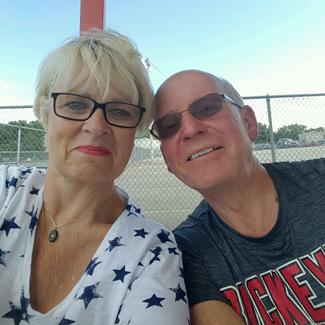
He was in a coma for two weeks and spent three months in the hospital. But that was just the beginning of his long road back. He had to re-learn how to talk, walk, eat, read, write—everything.
What’s more, he’d lost all memories from his first 12 years. He had to be told who his parents were, his siblings, his friends. Before the accident, he’d been a top student and an avid baseball and basketball player. After the accident, all that changed.
“I went from straight-As to Ds and Fs, barely passing, because I couldn’t remember anything,” Mike says. “I couldn’t even walk 50 feet until my senior year in high school. It was a tough time.”
Still, his family—his parents, his brothers and sisters, his grandparents, aunts and uncles—all rallied behind him. And slowly, amazingly, he healed. Not only was he able to eventually walk and run again, but by his 20s, he was playing in a softball league and earning a 3.4 grade point average in college.
From there, his life took off. In the decades since, he’s been a chemical engineer, the owner of a popular pizzeria and a devoted basketball coach at a local school. He has a wife, Genevieve, four daughters and seven grandchildren.
Mike describes himself as a very spiritual person. And through the years, a question gnawed at him.
“Why did God let me live?” he wondered. “Why was my life spared?”
Jacob’s story
On the day that Aileen and Chad noticed their son Jacob’s yellow eyes, they weren’t too worried. Their older son, Lucas, had been jaundiced after birth, and after some simple phototherapy treatment, he had been fine.
The next day, a Monday, they took Jacob to his pediatrician. By that night, Jacob was hospitalized in San Diego, about 100 miles from the family’s home in Imperial County. The next morning, he was transferred by ambulance to yet another San Diego hospital.
“That’s when we knew it was something serious,” says his dad.
That “something serious” turned out to be biliary atresia, a rare condition where the liver’s bile ducts are missing or blocked. When Jacob was 6 weeks old, he underwent surgery to try to repair the problem, but soon he was in and out of the hospital again.
His belly would fill with so much fluid, it swelled up like a balloon. Worse, that fluid often got infected. His parents learned to look for the telltale sign that they needed to take him to the emergency room: He’d stop smiling.
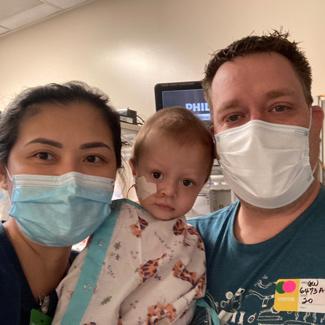
“Even with a distended belly, Jacob would be happy, but when he had an infection, there’d be no smile,” Chad explains.
In June, Jacob was referred to Children’s Hospital Los Angeles for a liver transplant. His parents met with Dr. Genyk, Chief of the Division of Abdominal Transplantation at CHLA, who has led the Liver and Intestinal Transplant Program for 22 years. Dr. Genyk partners with Beth Carter, MD, who is Medical Director of Liver Transplant and Intestinal Rehabilitation.
The program performs 25 to 30 transplants a year—the most in Southern California—with survival rates that exceed national averages. One third of those transplants come from living donors.
“The advantage of the living donor is that you can do the transplant before the patient’s condition really deteriorates,” Dr. Genyk explains. “Outcomes from living donors are generally superior to cadaveric donors, and that’s especially important for pediatric patients. A child needs a liver to last a really long time.”
Luckily, Jacob’s dad was a match. Chad spent a full day undergoing a thorough medical evaluation at Keck Medicine of USC. He thought doctors would just tell him to lose a few pounds. Instead, they had stunning news.
The imaging tests had revealed a tumor growing in Chad’s abdomen. He now had his own medical crisis—and he could not be a donor for Jacob.
“Our son getting sick during the pandemic, and now Chad? I felt like my world was falling apart,” Aileen says. “If it wasn’t for my faith in God, I don’t think I could have handled it.”
A surprise phone call
Meanwhile, Jacob was getting sicker.
In September, he spent 22 days in a San Diego hospital with a potentially life-threatening infection. He recovered, but it was clear he needed a transplant very soon. Still, he was nowhere near the top of the list to receive a deceased donor organ.
The family stepped up the search for a donor, but it was a slow process. Donating a liver is major surgery, requiring days in the hospital and a weekslong recovery. A few friends had expressed interest, but none so far had been found eligible.
Then, at 4 p.m. on Oct. 12, the family got its most astonishing news yet.
Chad was just pulling into the driveway of his mom’s house when his cell phone rang. It was Children’s Hospital Los Angeles. An anonymous person from Ohio had come forward to be a liver donor. Dr. Genyk had determined Jacob was the best match. Could Jacob be in Los Angeles for the transplant next week?
Anonymous donor? Ohio? Next week?
“Words literally could not come out of my mouth,” Chad says. “Someone in Ohio is coming out to L.A. to save my kid’s life? That’s, that’s—I don’t know what to say. Other than it’s proof that there’s still good in humanity, OK?”
A quest to give back
Three hours earlier, at his home in Sandusky, Ohio, Mike Speck had also received a surprise call from Los Angeles. As soon as he got off the phone, he jumped up from his chair and ran to find his wife.
“Genevieve!” he yelled, breathless with excitement. “You’re never going to guess who just called me.”
Five years earlier, in his continued quest to give back after his long-ago accident, Mike had anonymously donated one of his kidneys. The recipient, a minister, wrote him a letter, telling him the kidney had made him “a new man.”
Mike was thrilled. So when he later found out he could also donate a piece of his liver, he researched hospitals and contacted Keck Medicine of USC. In March 2020, he flew out to Los Angeles for a full donor evaluation. Since then, he’d been waiting for a phone call, hoping he could once again give someone else a second chance at life. Now, that call had come.
He and Genevieve began rushing around, packing their bags and booking a flight and hotel. Two days later, they were landing at LAX.
‘In good hands’
At 9:30 a.m. on Oct. 20, Aileen and Chad saw Jacob off to the most important surgery of his 10-month-old life. Jacob was in good spirits, giving his parents high fives with his tiny hands—and smiling his trademark smile.
His parents headed to their nearby hotel for the long wait. “We knew he was in good hands,” Chad says.
Dr. Genyk led both surgical teams—one for Mike at Keck Medicine of USC, and one for Jacob at Children’s Hospital Los Angeles. In all, the two surgeries took 13 hours.
“Jacob’s transplant was extremely difficult,” Dr. Genyk says. “He was really ill. Because of the infections in his abdomen, it took us three hours just to free up the intestine and liver from all the inflammation.”
But that’s where the experience of 399 previous pediatric liver transplants pays off.
“Reaching this milestone really speaks to the depth and breadth of our expertise,” Dr. Carter says. “When you’ve performed that many transplants, you become very adept at knowing what the potential complications are and how to prevent and treat them if they occur. This allows us to deliver the best possible care for each child.”
That care involves surgeons, gastroenterologists, hepatologists, nurses, radiologists, social workers and more. “Every transplant is a huge team effort,” Dr. Genyk stresses. “The success of this program is because of everyone’s enormous contributions.”
Tears across the miles
A month after the transplant—and less than 24 hours before Chad was scheduled for his own surgery—he and Aileen nervously logged onto a Zoom call. Jacob sat on Chad’s lap, bouncing and smiling and clutching a toy dinosaur.
On the screen waiting for them were Mike and Genevieve.
Shortly after Jacob’s successful transplant, Aileen and Chad had written a thank-you letter to Mike. At that point, he was still anonymous to them, but they had asked if he would be willing to meet them. They wanted to thank him in person.
Because of COVID-19 and the more than 2,000 miles between them, the meeting took place on Zoom. But that didn’t make it any less emotional. The tears were flowing freely in California and Ohio.
“I felt very humbled to see the effects of what transpired after my donation,” Mike says. “To see Jacob, to see his big smile—that was something. It was a tremendous experience.”
Aileen and Chad listened in awe to Mike’s journey.
“It was hearing his story and his motivation to donate that made me tear up,” Chad explains. “He was telling us it was his privilege to donate. We should all strive to be like Mike.”
“We are so thankful Mike came into our lives,” Aileen says. “He gave a second life to our son.”
‘The biggest reward’
Today, Jacob is doing great and cruising around the house with a baby walker. He recently celebrated his first birthday. His smile is bigger than ever.
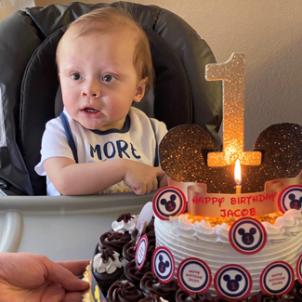
“Children transform so fast after liver transplant,” Dr. Genyk says. “The biggest reward is to see the outcomes in our patients and witness that event where their life is given back to them.”
Jacob’s family has another reason to smile, too: Chad’s November surgery in San Diego was a success, and he is doing well. The tumor was completely removed, and the post-op biopsy showed it was not cancerous.
“It’s such a blessing to be back to our normal life and to have Jacob healthy,” says Aileen. “We are so thankful to Dr. Genyk and all the doctors and nurses at Children’s Hospital Los Angeles for everything they have done to support us.”
Mike is also feeling great and is back to walking his usual 20,000 steps a day—even in the Ohio cold. He has donated all the organs he can as a living person. But he has another plan to keep giving the gift of life.
He’s already signed up to give blood.
